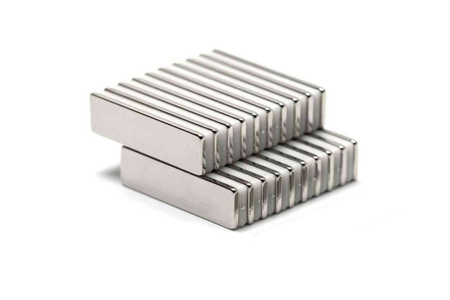Neodymium magnets
Neodymium magnets, often referred to as "supermagnets" or "neodymiums," are at present the most powerful permanent magnets in the world. Their exceptional strength and many practical applications make neodymium magnets one of the most desirable magnets on the market.
Neodymium magnets (NdFeB) are an alloy of the rare element neodymium (Nd), iron (Fe) and boron (B). Thanks to their properties, these super-strong magnets can lift a thousandfold of their weight!
The advantage of neodymium magnets, in addition to their strength, is their compactness, smallness, and lightness. These make it easy to integrate them into various devices and applications.
The force (breakaway strength) of neodymium magnets is given by:
- the magnet size - the bigger the magnet, the stronger the magnet (the greater clamping force)
- the material from which the magnet is made (magnetization degree) - we distinguish several degrees of magnetization - in more detail below
- the thickness of the metal material on which the magnet is clamped - the thicker the material, the higher the resulting clamping magnet force. The same magnet clamped on a 1 mm thick metal sheet will be weaker (it will have less clamping force) than a magnet clamped on a 10 mm thick sheet.
- the air gap between the magnet and the material on which the magnet is clamped - increasing the air gap between the magnet and the surface of the metal material reduces the clamping magnet force. The air layer can be formed by various materials, e.g. wood, plastic, paper, corrosion, paint, etc.
Magnetic properties (degree of magnetization) are the fundamental parameter that is given for each neodymium magnet.According to the mutual ratio of the elements (Nd, Fe, B) from which the neodymium magnet is made we distinguish different degrees of magnetization. They are marked with the number stated in the magnet designation. The numbers 33, 35, 40,... 55 indicate the maximum energy product MGOe. For simplicity, the higher the number, the stronger the magnet. Thus, a magnet marked N52 will be stronger than a magnet of the same size marked N35.
When choosing neodymium magnets, we must pay attention to the temperature at which they will be used. Therefore, neodymium magnets are always characterized by their maximum working temperature (when exceeding it, magnets gradually lose their magnetic properties!). The maximum working temperature (temperature resistance) is indicated by the letters N, M, H, AH,...
| Magnet designation | Temperature resistance (max. working temperature) |
|---|---|
| N | 80 °C |
| M | 100 °C |
| H | 120 °C |
| SH | 150 °C |
| UH | 180 °C |
| EH | 200 °C |
| AH | 230 °C |
Neodymium magnets are susceptible to corrosion (sensitivity also to atmospheric moisture) - therefore they are surface treated.
The most common types of surface treatments include:
- Nickel (Ni - Cu - Ni) - shiny metallic paint, thickness c. 12 microns
- Zinc (Zn) - matt grey color, thickness c. 4 microns
- Epoxy resin (Ni-Cu-Ni-Epoxy) - black color, high corrosion resistance, thickness c. 10 microns
- Chromium (Ni-Cu-Ni-Cr) - matt metallic paint, thickness c. 15 microns
- Gold (Ni-Cu-Ni-Au) - gold color paint, thickness c. 12 microns
- Passivation - dark grey color paint, very susceptible to corrosion, thickness c. 1 micron
It should be noted that neodymium magnets are so strong that they require care in handling. They can quickly pull together and cause an injury. In some cases, they may crack or damage their surface treatment. Therefore, it is important to treat them with respect and follow safety instructions.
Overall, neodymium magnets are a fascinating material with incredible magnetic strength and a wide range of uses, starting with industrial applications up to fun toys.
Comparison of different types of permanent magnets
A basic comparison of the different types of permanent magnets can be found in the table as follows.
| Magnet type | Holding force | Temperature resistance | Price | Chemical resistance | Corrosion resistance |
|---|---|---|---|---|---|
| Ferrite magnet | 250 °C | ||||
| Neodymium NdFeB magnet | 80 - 230 °C | ||||
| Samarium SmCo magnet | 350 °C | ||||
| AlNiCo magnet | 450 °C |







